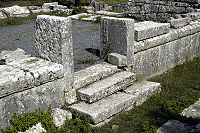
Orthostates
Encyclopedia

Course (architecture)
A course is a continuous horizontal layer of similarly-sized building material one unit high, usually in a wall. The term is almost always used in conjunction with unit masonry such as brick, cut stone, or concrete masonry units .-Styles:...
of orthostates, it is common to lay a course of stones spanning the width of the wall and joining its two faces (a binder course).
The term has been generalized for use in the description of the architecture of many cultures. In Assyrian practice, orthostates are often intricately carved. The term may be used more generally of other upright-standing stones, including megalithic menhirs.

